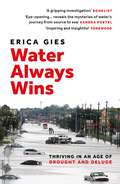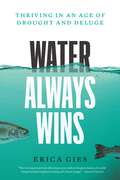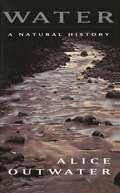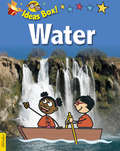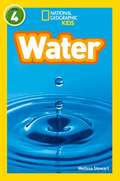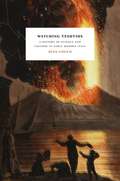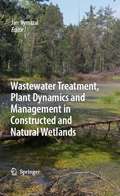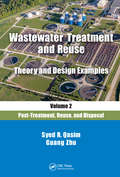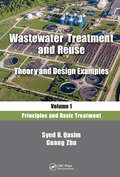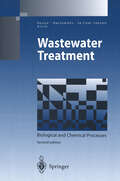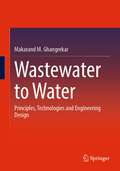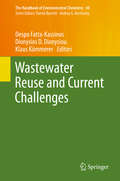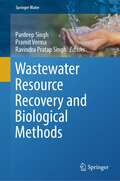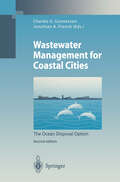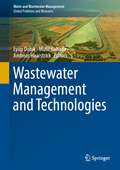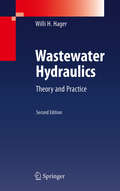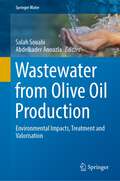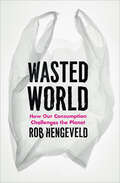- Table View
- List View
Water Always Wins: Thriving in an Age of Drought and Deluge
by Erica GiesA journey through time and around the world to uncover water's true nature, and how it can help us adapt to climate change.Trouble with water – increasingly frequent, extreme floods and droughts – is one of the first obvious signs of climate change. Meanwhile, urban sprawl, industrial agriculture and engineered water infrastructure are making things worse. As our control attempts fail, we are forced to recognize an eternal truth: sooner or later, water always wins.Award-winning science journalist Erica Gies follows water 'detectives' as they search for clues to water's past and present. Their tools: cutting-edge science and research into historical ecology, animal life, and earlier human practices. Their discoveries: a deeper understanding of what water wants and how accommodating nature can protect us and other species.Modern civilizations tend to speed water away. We have forgotten that it must flex with the rhythms of the earth, and that only collaboration with nature will allow us to forge a more resilient future.
Water Always Wins: Thriving in an Age of Drought and Deluge
by Erica GiesA hopeful journey around the world and across time, illuminating better ways to live with water. Nearly every human endeavor on the planet was conceived and constructed with a relatively stable climate in mind. But as new climate disasters remind us every day, our world is not stable—and it is changing in ways that expose the deep dysfunction of our relationship with water. Increasingly severe and frequent floods and droughts inevitably spur calls for higher levees, bigger drains, and longer aqueducts. But as we grapple with extreme weather, a hard truth is emerging: our development, including concrete infrastructure designed to control water, is actually exacerbating our problems. Because sooner or later, water always wins. In this quietly radical book, science journalist Erica Gies introduces us to innovators in what she calls the Slow Water movement who start by asking a revolutionary question: What does water want? Using close observation, historical research, and cutting-edge science, these experts in hydrology, restoration ecology, engineering, and urban planning are already transforming our relationship with water. Modern civilizations tend to speed water away, erasing its slow phases on the land. Gies reminds us that water’s true nature is to flex with the rhythms of the earth: the slow phases absorb floods, store water for droughts, and feed natural systems. Figuring out what water wants—and accommodating its desires within our human landscapes—is now a crucial survival strategy. By putting these new approaches to the test, innovators in the Slow Water movement are reshaping the future.
Water: A Natural History
by Alice OutwaterAn environmental engineer turned ecology writer relates the history of our waterways and her own growing understanding of what needs to be done to save this essential natural resource.Water: A Natural History takes us back to the diaries of the first Western explorers; it moves from the reservoir to the modern toilet, from the grasslands of the Midwest to the Everglades of Florida, through the guts of a wastewater treatment plant and out to the waterways again. It shows how human-engineered dams, canals and farms replaced nature's beaver dams, prairie dog tunnels, and buffalo wallows. Step by step, Outwater makes clear what should have always been obvious: while engineering can de-pollute water, only ecologically interacting systems can create healthy waterways.Important reading for students of environmental studies, the heart of this history is a vision of our land and waterways as they once were, and a plan that can restore them to their former glory: a land of living streams, public lands with hundreds of millions of beaver-built wetlands, prairie dog towns that increase the amount of rainfall that percolates to the groundwater, and forests that feed their fallen trees to the sea.
Water (Espresso: Ideas Box #6)
by Sarah RidleyJoin Polly, Kim and the rest of the Espresso team to find out all about water. Explore where our tap water comes from, how water makes electricity and what a monsoon is. Plus learn to paint like the Impressionists, make a cloud in a jam jar and much more!This book is part of the Espresso Ideas Box series, which have a wealth of information and ideas for exploring topics in a cross-curricular way. They are produced in association with Espresso Education, the leading digital curriculum service in the UK - used in over 10,000 primary schools.
Water: Level 4 (National Geographic Readers Ser.)
by Melissa Stewart National Geographic Kids StaffNational Geographic Primary Readers is a high-interest series of beginning reading books that have been developed in consultation with education experts. The books pair magnificent National Geographic photographs with lively text by skilled children’s book authors across four reading levels. Water is all around us; we drink it every day. In this level 4 reader, kids will learn about the water cycle, discovering how rain and snow flow into our lakes, rivers, and oceans, and later evaporate into the sky again. Vivid photography and accessible text make this book an ideal introduction to the science of water. Level 4: Independent reader: Perfect for kids who are reading on their own with ease and are ready for more challenging vocabulary with varied sentence structures. They are ideal for readers of White and Lime books.
Watching Vesuvius: A History of Science and Culture in Early Modern Italy
by Sean CoccoMount Vesuvius has been famous ever since its eruption in 79 CE, when it destroyed and buried the Roman cities of Pompeii and Herculaneum. But less well-known is the role it played in the science and culture of early modern Italy, as Sean Cocco reveals in this ambitious and wide-ranging study. Humanists began to make pilgrimages to Vesuvius during the early Renaissance to experience its beauty and study its history, but a new tradition of observation emerged in 1631 with the first great eruption of the modern period. Seeking to understand the volcano’s place in the larger system of nature, Neapolitans flocked to Vesuvius to examine volcanic phenomena and to collect floral and mineral specimens from the mountainside. In Watching Vesuvius, Cocco argues that this investigation and engagement with Vesuvius was paramount to the development of modern volcanology. He then situates the native experience of Vesuvius in a larger intellectual, cultural, and political context and explains how later eighteenth-century representations of Naples—of its climate and character—grew out of this tradition of natural history. Painting a rich and detailed portrait of Vesuvius and those living in its shadow, Cocco returns the historic volcano to its place in a broader European culture of science, travel, and appreciation of the natural world.
Watching Vesuvius: A History of Science and Culture in Early Modern Italy
by Sean CoccoMount Vesuvius has been famous ever since its eruption in 79 CE, when it destroyed and buried the Roman cities of Pompeii and Herculaneum. But less well-known is the role it played in the science and culture of early modern Italy, as Sean Cocco reveals in this ambitious and wide-ranging study. Humanists began to make pilgrimages to Vesuvius during the early Renaissance to experience its beauty and study its history, but a new tradition of observation emerged in 1631 with the first great eruption of the modern period. Seeking to understand the volcano’s place in the larger system of nature, Neapolitans flocked to Vesuvius to examine volcanic phenomena and to collect floral and mineral specimens from the mountainside. In Watching Vesuvius, Cocco argues that this investigation and engagement with Vesuvius was paramount to the development of modern volcanology. He then situates the native experience of Vesuvius in a larger intellectual, cultural, and political context and explains how later eighteenth-century representations of Naples—of its climate and character—grew out of this tradition of natural history. Painting a rich and detailed portrait of Vesuvius and those living in its shadow, Cocco returns the historic volcano to its place in a broader European culture of science, travel, and appreciation of the natural world.
Watching Vesuvius: A History of Science and Culture in Early Modern Italy
by Sean CoccoMount Vesuvius has been famous ever since its eruption in 79 CE, when it destroyed and buried the Roman cities of Pompeii and Herculaneum. But less well-known is the role it played in the science and culture of early modern Italy, as Sean Cocco reveals in this ambitious and wide-ranging study. Humanists began to make pilgrimages to Vesuvius during the early Renaissance to experience its beauty and study its history, but a new tradition of observation emerged in 1631 with the first great eruption of the modern period. Seeking to understand the volcano’s place in the larger system of nature, Neapolitans flocked to Vesuvius to examine volcanic phenomena and to collect floral and mineral specimens from the mountainside. In Watching Vesuvius, Cocco argues that this investigation and engagement with Vesuvius was paramount to the development of modern volcanology. He then situates the native experience of Vesuvius in a larger intellectual, cultural, and political context and explains how later eighteenth-century representations of Naples—of its climate and character—grew out of this tradition of natural history. Painting a rich and detailed portrait of Vesuvius and those living in its shadow, Cocco returns the historic volcano to its place in a broader European culture of science, travel, and appreciation of the natural world.
Watching Vesuvius: A History of Science and Culture in Early Modern Italy
by Sean CoccoMount Vesuvius has been famous ever since its eruption in 79 CE, when it destroyed and buried the Roman cities of Pompeii and Herculaneum. But less well-known is the role it played in the science and culture of early modern Italy, as Sean Cocco reveals in this ambitious and wide-ranging study. Humanists began to make pilgrimages to Vesuvius during the early Renaissance to experience its beauty and study its history, but a new tradition of observation emerged in 1631 with the first great eruption of the modern period. Seeking to understand the volcano’s place in the larger system of nature, Neapolitans flocked to Vesuvius to examine volcanic phenomena and to collect floral and mineral specimens from the mountainside. In Watching Vesuvius, Cocco argues that this investigation and engagement with Vesuvius was paramount to the development of modern volcanology. He then situates the native experience of Vesuvius in a larger intellectual, cultural, and political context and explains how later eighteenth-century representations of Naples—of its climate and character—grew out of this tradition of natural history. Painting a rich and detailed portrait of Vesuvius and those living in its shadow, Cocco returns the historic volcano to its place in a broader European culture of science, travel, and appreciation of the natural world.
Wastewater Treatment, Plant Dynamics and Management in Constructed and Natural Wetlands
by Jan VymazalAt present, constructed wetlands for wastewater treatment are a widely used technology for treatment of various types of wastewaters. The International Water Association (then International Association on Water Pollution Research and Control) recognized wetlands as useful tools for wastewater treatment and est- lished the series of biennial conferences on the use of wetland systems for water pollution control in 1988. In about 1993, we decided to organize a workshop on nutrient cycling in natural and constructed wetlands with the major idea to bring together researchers working on constructed and also natural wetlands. It was not our intention to compete with IWA conferences, but the workshop should rather complement the series on treatment wetlands by IWA. We believed that the exchange of information obtained from natural and constructed wetlands would be beneficial for all participants. And the time showed that we were correct. The first workshop took place in 1995 at T?ebo? in South Bohemia and most of the papers dealt with constructed wetlands. Over the years we extended the topics on natural wetlands (such as role of wetlands in the landscape or wetland restoration and creation) and during the 6th workshop held at T?ebo? from May 30 to June 3, 2006, nearly half of 38 papers presented during the workshop dealt with natural wetlands. This workshop was attended by 39 participants from 19 countries from Europe, Asia, North and South Americas and Australia. The volume contains 29 peer-reviewed papers out of 38 papers which were presented during the workshop.
Wastewater Treatment and Reuse Theory and Design Examples, Volume 2: Post-Treatment, Reuse, and Disposal
by Syed R. Qasim Guang ZhuThis book will present the theory involved in wastewater treatment processes, define the important design parameters involved, and provide typical values of these parameters for ready reference; and also provide numerical applications and step-by-step calculation procedures in solved examples. These examples and solutions will help enhance the readers’ comprehension and deeper understanding of the basic concepts, and can be applied by plant designers to design various components of the treatment facilities. It will also examine the actual calculation steps in numerical examples, focusing on practical application of theory and principles into process and water treatment facility design.
Wastewater Treatment and Reuse Theory and Design Examples, Volume 2: Post-Treatment, Reuse, and Disposal
by Syed R. Qasim Guang ZhuThis book will present the theory involved in wastewater treatment processes, define the important design parameters involved, and provide typical values of these parameters for ready reference; and also provide numerical applications and step-by-step calculation procedures in solved examples. These examples and solutions will help enhance the readers’ comprehension and deeper understanding of the basic concepts, and can be applied by plant designers to design various components of the treatment facilities. It will also examine the actual calculation steps in numerical examples, focusing on practical application of theory and principles into process and water treatment facility design.
Wastewater Treatment and Reuse, Theory and Design Examples, Volume 1: Principles and Basic Treatment
by Syed R. Qasim Guang ZhuThis book will present the theory involved in wastewater treatment processes, define the important design parameters involved, and provide typical values of these parameters for ready reference; and also provide numerical applications and step-by-step calculation procedures in solved examples. These examples and solutions will help enhance the readers’ comprehension and deeper understanding of the basic concepts, and can be applied by plant designers to design various components of the treatment facilities. It will also examine the actual calculation steps in numerical examples, focusing on practical application of theory and principles into process and water treatment facility design.
Wastewater Treatment and Reuse, Theory and Design Examples, Volume 1: Principles and Basic Treatment
by Syed R. Qasim Guang ZhuThis book will present the theory involved in wastewater treatment processes, define the important design parameters involved, and provide typical values of these parameters for ready reference; and also provide numerical applications and step-by-step calculation procedures in solved examples. These examples and solutions will help enhance the readers’ comprehension and deeper understanding of the basic concepts, and can be applied by plant designers to design various components of the treatment facilities. It will also examine the actual calculation steps in numerical examples, focusing on practical application of theory and principles into process and water treatment facility design.
Wastewater Treatment: Biological and Chemical Processes (Environmental Science and Engineering)
by Mogens Henze Poul Harremoes Erik Arvin Jes LaCour JansenWastewater to Water: Principles, Technologies and Engineering Design
by Makarand M. GhangrekarThis textbook offers a complete comprehensive coverage of wastewater engineering from pollutant classification, design of collection systems and treatment systems including operational guidelines for the treatment plants. Apart from the primary and conventional secondary wastewater treatment, this book covers the details and design of advanced biological treatment systems such as sequencing batch reactor (SBR), up-flow anaerobic sludge blanket (UASB) reactors and hybrid reactor, with design examples and photographs of actual working reactors which is useful for students and practicing engineers. This textbook is designed to provide complete solution for the wastewater engineering for easy reference to the users. This textbook is an ideal reference for courses taught at the university undergraduate and postgraduate level in the field of civil/environmental engineering, chemical engineering, water management and environmental science. It should also appeal to practicing engineers in the wastewater engineering and effluent treatment plant designers.
Wastewater Reuse and Current Challenges (The Handbook of Environmental Chemistry #44)
by Despo Fatta-Kassinos Dionysios D. Dionysiou Klaus KümmererThis volume discusses the current challenges related to the reuse of wastewater. It reviews the analytical methodologies for evaluating emerging contaminants and their transformation products, the sensitivity of various bioassays for assessing the biological effects of treated wastewater, and the bioavailability and uptake of organic contaminants during crop irrigation. It describes in detail the physicochemical and microbiological alterations in soil resulting from irrigation with treated urban wastewater, and discusses our current understanding of antibiotic resistance in wastewater treatment plants and in downstream environments. The book also includes an analysis of the effect of wastewater entering drinking water sources and production, and provides updated information on wastewater reuse for irrigation in North Africa. It presents an important integration tool for water recovery, known as water pinch analysis, and finally showcases two other examples of reuse – one in the paper industry and one in landfill management. It is of interest to experts from various fields of research, including analytical and environmental chemistry, toxicology and environmental and sanitary engineering.
Wastewater Resource Recovery and Biological Methods (Springer Water)
by Pardeep Singh Pramit Verma Ravindra Pratap SinghThe book is unique in highlighting the issue of wastewater as one of the important environmental issues. The uniqueness also lies in exploring the concepts of converting waste into resources in the form of bioenergy, biofertilizers through various biological methods. Given the international scenario, the chapters of this book are designed to include both anaerobic and aerobic methods of resource recovery from the industrial wastewater. The book is a step toward design with nature and the concept of green chemistry.Waste menace is one of the most voiced and unsolved problems in the entire world. The whole world is facing the threat of water pollution, soil pollution/ land pollution, odour pollution from the growing waste. Though we find many missions and programs at international, national, and regional level to solve the waste associated issues, this is mostly in context with the solid fraction of the waste. Very little is being done to manage the liquid part of the waste or what we call the wastewater.The conversion of wastewater has the potential to be converted to energy in the form bioenergy, bio-fertilizers, electricity, nutrient recovery, etc. The use of sludge as biofertilizers solves the problem of sludge management on the one hand and production of organic crops on the other. The biological treatment methods like sludge treatment gives the farmers the source of biofertilizers and organic manure for the plants. In the present scenario, energy crisis is also one of the issues that we are facing particularly in context with the thermal power plants which are environmentally highly polluting. Through various techniques like microbial fuel cells or biohydrogen, we get a source of cleaner energy. So, through this book, we try to produce the content and information to give the audience an understanding of the waste water as one of the environmental and health issues and mitigation strategies. The book gives a sufficient understanding of how waste can be turned into a resource.
Wastewater Management for Coastal Cities: The Ocean Disposal Option (Environmental Science and Engineering)
by Q. M. Lu J. F. Knudsen S. K. Eskesen J. T. Powers F. Shremp D. A. Segar E. Stamman Z. YuchengProtection of coastal waters from direct pollution by coastal cities is a vital task in preserving marine ecosystems and promoting human health. This book, edited by two leading experts on wastewater management for coastal cities, delves deeply into the ecological and oceanographic fundamentals that are essential for understanding of what happens to wastes discharged into the nearshore marine environment. It explains the requirements for rational engineering design and operation of the physical and institutional components of coastal city wastewater management, and it provides guidelines for hydraulic design, ocean outfall construction, monitoring, cost recovery, and other economic aspects. Case studies are included, drawn from the editors' worldwide field experience.
Wastewater Management and Technologies (Water and Wastewater Management)
by Eyüp Debik Müfit Bahadir Andreas HaarstrickThis book edition on "Wastewater Management and Technologies" brings together a wealth of expertise by the authors, who exemplify the wide range of options available—from nature-based solutions to different levels of technology—and the different experiences through case studies from around the world, with a particular focus on conditions in developing countries. The book is part of a book series (special editions) based on the publication of the book "Water and Wastewater Management", published by Springer in 2022 (ISBN 978-3-030-9528-7). The part about "Wastewater Management and Technologies" edited in this book will be deepened with this first special edition in terms of technological topics.
Wastewater Hydraulics: Theory and Practice
by Willi H. HagerThe second, enlarged edition of this established reference integrates many new insights into wastewater hydraulics. This work serves as a reference for researchers but also is a basis for practicing engineers. It can be used as a text book for graduate students, although it has the characteristics of a reference book. It addresses mainly the sewer hydraulician but also general hydraulic engineers who have to tackle many a problem in daily life, and who will not always find an appropriate solution. Each chapter is introduced with a summary to outline the contents. To illustrate application of the theory, examples are presented to explain the computational procedures. Further, to relate present knowledge to the history of hydraulics, some key dates on noteworthy hydraulicians are quoted. A historical note on the development of wastewater hydraulics is also added. References are given at the end of each chapter, and they are often helpful starting points for further reading. Each notation is defined when introduced, and listed alphabetically at the end of each chapter. This new edition includes in particular sideweirs with throttling pipes, drop shafts with an account on the two-phase flow features, as well as conduit choking due to direct or undular hydraulic jumps.
Wastewater from Olive Oil Production: Environmental Impacts, Treatment and Valorisation (Springer Water)
by Salah Souabi Abdelkader AnouzlaThis book summarizes the recent research development concerning olive oil wastewater management: characterization, environmental impact, recovery and treatment. The book combines different chapters on the management of olive oil rejects using simple techniques with low investment and operating costs. The main focus of the book is:- Diagnosis, impacts of olive oil waste, and regulations- The valorization of the margins and the olive waste- Wastewater treatment and recovery- Evaluation of investments and operating costs of treatment techniques- Shaped by experience, the authors present their view and approach to each focus area of managing liquid and solid waste produced by crushing units.
Wasted World: How Our Consumption Challenges the Planet
by Rob HengeveldAll systems produce waste as part of a cycle—bacteria, humans, combustion engines, even one as large and complex as a city. To some extent, this waste can be absorbed, processed, or recycled—though never completely. In Wasted World, Rob Hengeveld reveals how a long history of human consumption has left our world drowning in this waste. This is a compelling and urgent work that traces the related histories of population growth and resource consumption. As Hengeveld explains, human life (and population growth) depends not only on mineral resources but also on energy. People first obtained energy from food and later supplemented this with energy from water, wind, and animals as one source after another fell short of our ever-growing needs. Finally, we turned to fossil energy, which generates atmospheric waste that is the key driver of global climate change. The effects of this climate change are already leading to food shortages and social collapse in some parts of the world. Because all of these problems are interconnected, Hengeveld argues strenuously that measures to counter individual problems cannot work. Instead, we need to tackle their common cause—our staggering population growth. While many scientists agree that population growth is one of the most critical issues pressuring the environment, Hengeveld is unique in his insistence on turning our attention to the waste such growth leaves in its wake and to the increasing demands of our global society. A practical look at the sustainability of our planet from the perspective of a biologist whose expertise is in the abundances and distributions of species, Wasted World presents a fascinating picture of the whole process of using, wasting, and exhausting energy and material resources. And by elucidating the complexity of the causes of our current global state, Hengeveld offers us a way forward.
Wasted World: How Our Consumption Challenges the Planet
by Rob HengeveldAll systems produce waste as part of a cycle—bacteria, humans, combustion engines, even one as large and complex as a city. To some extent, this waste can be absorbed, processed, or recycled—though never completely. In Wasted World, Rob Hengeveld reveals how a long history of human consumption has left our world drowning in this waste. This is a compelling and urgent work that traces the related histories of population growth and resource consumption. As Hengeveld explains, human life (and population growth) depends not only on mineral resources but also on energy. People first obtained energy from food and later supplemented this with energy from water, wind, and animals as one source after another fell short of our ever-growing needs. Finally, we turned to fossil energy, which generates atmospheric waste that is the key driver of global climate change. The effects of this climate change are already leading to food shortages and social collapse in some parts of the world. Because all of these problems are interconnected, Hengeveld argues strenuously that measures to counter individual problems cannot work. Instead, we need to tackle their common cause—our staggering population growth. While many scientists agree that population growth is one of the most critical issues pressuring the environment, Hengeveld is unique in his insistence on turning our attention to the waste such growth leaves in its wake and to the increasing demands of our global society. A practical look at the sustainability of our planet from the perspective of a biologist whose expertise is in the abundances and distributions of species, Wasted World presents a fascinating picture of the whole process of using, wasting, and exhausting energy and material resources. And by elucidating the complexity of the causes of our current global state, Hengeveld offers us a way forward.
Wasted World: How Our Consumption Challenges the Planet
by Rob HengeveldAll systems produce waste as part of a cycle—bacteria, humans, combustion engines, even one as large and complex as a city. To some extent, this waste can be absorbed, processed, or recycled—though never completely. In Wasted World, Rob Hengeveld reveals how a long history of human consumption has left our world drowning in this waste. This is a compelling and urgent work that traces the related histories of population growth and resource consumption. As Hengeveld explains, human life (and population growth) depends not only on mineral resources but also on energy. People first obtained energy from food and later supplemented this with energy from water, wind, and animals as one source after another fell short of our ever-growing needs. Finally, we turned to fossil energy, which generates atmospheric waste that is the key driver of global climate change. The effects of this climate change are already leading to food shortages and social collapse in some parts of the world. Because all of these problems are interconnected, Hengeveld argues strenuously that measures to counter individual problems cannot work. Instead, we need to tackle their common cause—our staggering population growth. While many scientists agree that population growth is one of the most critical issues pressuring the environment, Hengeveld is unique in his insistence on turning our attention to the waste such growth leaves in its wake and to the increasing demands of our global society. A practical look at the sustainability of our planet from the perspective of a biologist whose expertise is in the abundances and distributions of species, Wasted World presents a fascinating picture of the whole process of using, wasting, and exhausting energy and material resources. And by elucidating the complexity of the causes of our current global state, Hengeveld offers us a way forward.
